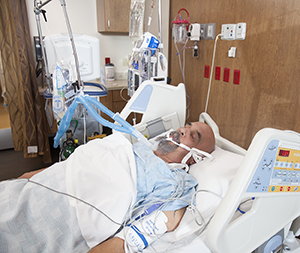Understanding Ventilators
A ventilator is a machine that helps a person breathe. If someone you care about is on a ventilator, you may have questions.

Why a ventilator?
Ventilators are used in the following ways:
-
A ventilator is needed when a person can’t breathe well on their own. People need to take in oxygen and exhale carbon dioxide. A ventilator can help with both functions.
-
Sometimes, breathing takes too much of a person’s energy. If so, the ventilator can take over and do the work, so their body can concentrate on fighting infection or recovering.
-
Ventilators are common during or after certain surgeries and for lung illnesses.
How long is it used?
Ventilators are used for a certain length of time as follows:
-
A ventilator can be used for a few hours to a few months or years. How long it is used depends on why it's needed.
-
If the ventilator attached to a tube in the mouth or nose is needed for more than a few weeks, the vocal cords can become damaged. To protect the vocal cords, the breathing tube may be relocated and placed into an opening made in the person’s throat (tracheostomy). The tracheostomy tube is then connected to the ventilator. It can stay in as long as needed. It may be possible for a person to talk or eat with a tracheostomy tube in place.
Keep your loved one comfortable
Here are ways to help your loved one stay comfortable:
-
A healthcare provider is always nearby to check on your loved one.
-
If awake, the person will be able to hear, but not speak. Writing pads and other tools can help them communicate.
-
Know that medicine given to help the person relax can also make them confused and sleepy.
What you may notice
Be prepared to see the following:
-
A breathing tube carries oxygen from the ventilator to the person. This tube enters their mouth or nose.
-
Monitors, lights, and alarms alert care providers to changes or problems.
-
Additional tubes that may give the person fluid, nutrition, and medicine. These tubes may also help with other tasks, such as emptying their bladder.
-
Restraints may hold your loved one’s wrists. These keep them from accidentally pulling out tubes. But they don’t stop them from moving or using the button to call for a healthcare provider.
-
The person may be given medicine that prevents movement. This helps conserve their energy. Medicine can also help them relax and sleep.
-
The healthcare team will suction the person regularly to keep the airway clear of mucus.
How you can help
Here's how you can help your loved one:
-
Ask the healthcare provider how long and often you should visit. Some people may do better with a loved one nearby but others may get too tired.
-
Don't panic if alarms go off. Healthcare providers will respond. Your loved one is more likely to stay calm if you do.
-
A person on a ventilator can catch some illnesses more easily. Don’t visit if you’re sick.
-
At times, you may be asked to wear a mask over your mouth and nose.
-
Follow any instructions the healthcare provider gives you.
-
If you have concerns or questions, write them down and ask the healthcare provider.
Online Medical Reviewer:
L Renee Watson MSN RN
Online Medical Reviewer:
Marianne Fraser MSN RN
Online Medical Reviewer:
Rita Sather RN
Date Last Reviewed:
8/1/2023
© 2000-2024 The StayWell Company, LLC. All rights reserved. This information is not intended as a substitute for professional medical care. Always follow your healthcare professional's instructions.